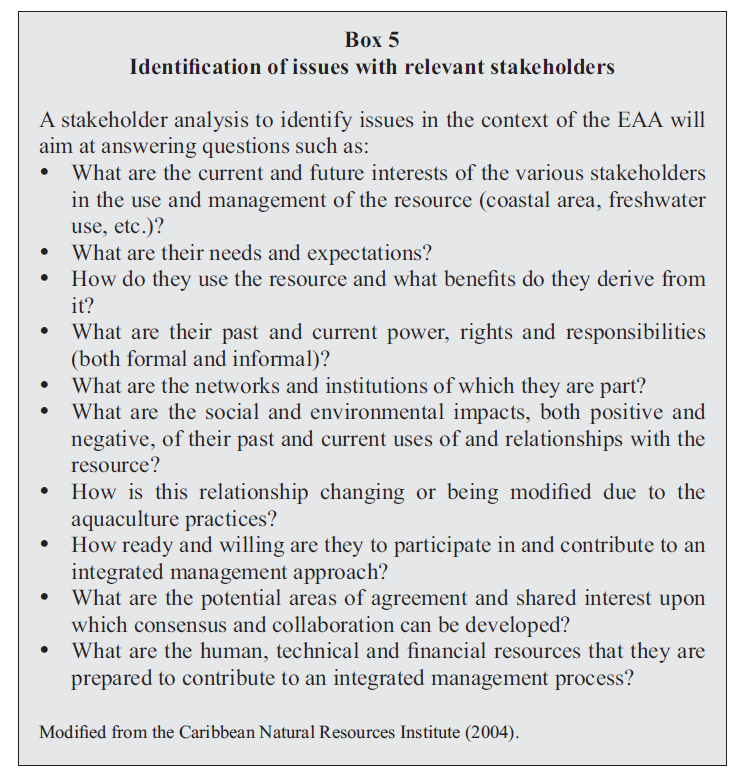Community Planning
Before engaging in a community aquaculture project in a reef area, it is critical that scoping, planning, outreach, and partnerships are made to ensure the highest chances of success for seafood production, coastal livelihoods, and the protection of reef ecosystems. Coastal marine aquaculture should be planned and managed in collaboration with local stakeholders to provide the greatest value to coastal communities while minimizing impacts on the ecosystems on which they depend. Stakeholder engagement is essential for building the trust, relationships, and support that will be required for ongoing management. Aquaculture is a sector where there are likely to be many different types of stakeholders involved in policy making, planning, and management of the activity. Stakeholders could include scientists, aquaculture farmers, fishers, restoration practitioners, homeowners, marine businesses, managers, government officials, coastal recreational users, among others. ref
The Food and Agriculture Organization of the United Nations (FAO) developed a list of criteria to identify areas of interests to relevant stakeholders using an ecosystem approach to aquaculture or EAA. Identifying the current and potential resource use constraints within the marine environment is one of the most essential steps in managing aquaculture in a sustainable and conflict-free way.

Identification of areas of interest to relevant stakeholders. Source: FAO 2010
Good governance of aquaculture includes the promotion of inclusiveness, lawfulness, and accountability (FAO, 2010). For this reason, it is important for managers to ask questions and hear concerns of the community about whether and/or how to engage in aquaculture in reef areas.
These questions include, but are not limited to:
Aquaculture Needs Assessment
- Have stakeholders noticed a decline in wild fisheries due to overfishing?
- Have local fishers noticed a decline in fished species abundance?
- Have local fishers noticed a decrease in individual fished species size?
- Do local fishers regularly need to find new fishing grounds?
- Are stakeholders having issues with food security?
- Is the local community/state/island/country reliant on other countries for the import of protein?
- Are there regular food shortages in the community?
- Are there habitats or waterbodies in need of restoration or support?
- Has there been a decline in native seaweed forests, native oyster reefs, or coral reefs?
- Are there excess nutrients in the local waterbodies / eutrophic areas in need of filtration?
- Are there socio-economic needs of the community that are not being served by other industries?
- Is there a lack of local employment that can be satisfied by aquaculture farming?
- Are stakeholders interested in learning more about aquaculture as an avenue for employment and economic benefit?
- Is anyone within the community interested in starting an aquaculture farm or project? If so, who?
Potential Species to be Farmed
- What species are native to the reef area that could be cultured?
- Are there species that are in high demand for local consumption?
- Have local fishers noticed a decline in wild stocks of these species?
- Are stakeholders interested in farming local species to alleviate overfishing pressure and create a steady supply for local consumption or export?
- If there are fish stocks, habitat, or waterbodies in need of restoration or support, are stakeholders interested in farming “restorative” species, such as seaweed or shellfish?
Farming Methods
- Are there stakeholders that have experience in any type of aquaculture?
- If yes, what kind of method was employed and for what species?
- Does the local workforce have the skills and expertise to operate and manage a finfish production cage?
- If stakeholders are interested in aquaculture, what type of farming method might be best suited for the local environment and level of expertise?
- Do stakeholders have access to boats?
- What access to / tenure over the land and marine environment does the community have?
- Are there any stakeholders that have access to or tenure over a marine environment that can host a cage, floating lines, or shellfish bed?
- Do stakeholders understand the concept of sustainability?
- Do stakeholders hold the necessary skills to farm in an environmentally sustainable and economically profitable way?
Markets and Infrastructure

Economic aspects of sustainable aquaculture.
Once stakeholders identify possible species to farm, what is the current market?
- Do fishers sell selected species domestically, internationally or both?
- What is the local or international price for those species?
- Are these species sold whole or in fillets?
- Are the farms located next to transportation and have sufficient ability to get to market?
- If proposed cage locations have been identified by stakeholders, how far are the cages to a processing plant?
- How far is the processing plant to a point of transport?
- What is the mode of transport?
- How quick can the fish reach the market?
- Is there a functioning and potentially traceable supply chain from farmer to buyer to distributor to customers?
- Is there any record keeping in place to allow for traceability of the products?
- Do any stakeholders have experience with record keeping and traceability? If so, how can those skills be used for finfish production and sales?
Governance Structure
- Who governs aquaculture at the local, district, provincial/state, national level? (see Regulations to Support Sustainable Management page)
Once a manager has established who the relevant stakeholders are, what they are concerned about, and if aquaculture is viable at a site, they will need to determine how to engage with stakeholders and build momentum and interest in the engagement process. Managers may also want to consider possible barriers that may prevent stakeholders from participating and how to overcome those barriers to provide opportunities for stakeholders to meaningfully engage. Explore this case study on developing sustainable aquaculture in Palau.
